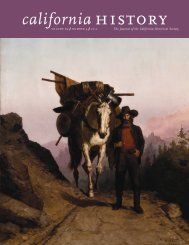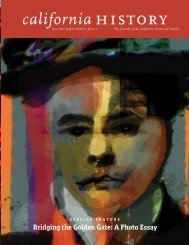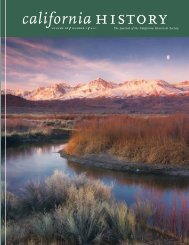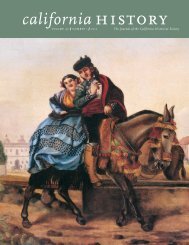california history - California Historical Society
california history - California Historical Society
california history - California Historical Society
Create successful ePaper yourself
Turn your PDF publications into a flip-book with our unique Google optimized e-Paper software.
without even allowing Siegel to continue hisspeech, the crowd simply “poured off the campuswith whoops and yells.” 43Upon approaching the intersection of TelegraphAvenue and Haste Street, the protesters encountereda well-formed line of Berkeley police andCHP officers who denied them access to the park.At that point, some demonstrators darted downan alley leading to the park, and county deputieschased in hot pursuit. The other demonstrators,unable to reach the park, remained on TelegraphAvenue, where some protesters, willing to adoptthe strategy of trashing fashionable Berkeley,smashed the glass door of the Bank of Americabuilding. Others engaged the police in whatPeter Barnes of Newsweek’s San Francisco bureaudescribed as the “cat-and-mouse tactics of guerrillaprovocation.” “The guerrillas seemed to haveperfected a set of counter-tactics: in the face ofa police charge, they melted quickly down sidestreets and regrouped for another sortie; after atear-gas barrage, they lurked just out of range ofthe fumes, hurling their missiles and chanting,‘We want the park.’” Barnes believed that “fewstudents actually threw anything more dangerousthan epithets,” but the police complainedthat they were hit with rocks, sticks, bricks,bottles, jagged pieces of pipe and steel, chunksof concrete, and cherry bombs (some with BBshot glued on to act as shrapnel). Ominously,the police claimed that many of these projectileswere thrown from the roofs of buildings thatlined Haste Street and Telegraph Avenue. ThoughBerkeley police had occupied the rooftops for earlierantiwar marches, Madigan had neglected toseize this strategic high ground. 44When the Sproul Plaza crowd first arrived atthe intersection of Telegraph and Haste at 12:30p.m., they were confronted by a contingent of159 officers that proved woefully insufficient tomaintain order. With reinforcements from theBerkeley Police Department, CHP, and AlamedaCounty Sheriff’s Department, the number oflaw enforcement swelled to 791 and order wasrestored. However, either the call for backup ortheir arrival was remarkably slow; reinforcementsdid not arrive until 2:15 p.m. In the interim,while besieged officers from the Berkeley PoliceDepartment and CHP refrained from using servicerevolvers, Sheriff Madigan issued shotgunsto his deputies, who quickly opened fire at therooftops and at the street level. 45Madigan later defended his use of firearmson the grounds that “our men were beingassaulted,” which left him no choice but “to usefirearms—because we didn’t have the availablemanpower—or retreat and abandon the cityof Berkeley to the mob.” To be fair, Madiganapparently had believed that protesters wouldbe confined to a small group of political radicalsand therefore greatly underestimated the troopstrength required to quell a rebellion. When thethousands of people from Sproul Plaza arrived,there actually were fewer officers on hand than at4:45 a.m., when they were rousting campers outof the park. Faced with a far larger demonstrationthan anticipated, Madigan overreacted andresorted to the use of indiscriminate gunfire. 46His decision resulted in the hospitalization ofthirty-two gunshot victims, a blinding, and a fatality.The People’s Park martyr, James Rector, washardly an active provocateur or an obvious targetfor police retaliation. He was a twenty-five-yearoldcarpenter from San Jose visiting friends inBerkeley and part of a crowd observing the streetbattle from atop the roof of Granma’s bookstoreIn the early morning hours of May 15, 1969, 250 localpolice and <strong>California</strong> Highway Patrol officers cleared thepark, destroyed a section of its plantings, and installeda chain-link fence around its perimeter. Thus began theevents known as Bloody Thursday, in which one bystanderwas killed and another was blinded. Forty-three protestersand bystanders required hospitalization, thirty-two fromgunshot wounds, and many other victims avoided medicaltreatment to prevent getting arrested at the hospital.© Photographs by Harold Adler <strong>California</strong> History • volume 88 number 1 2010









